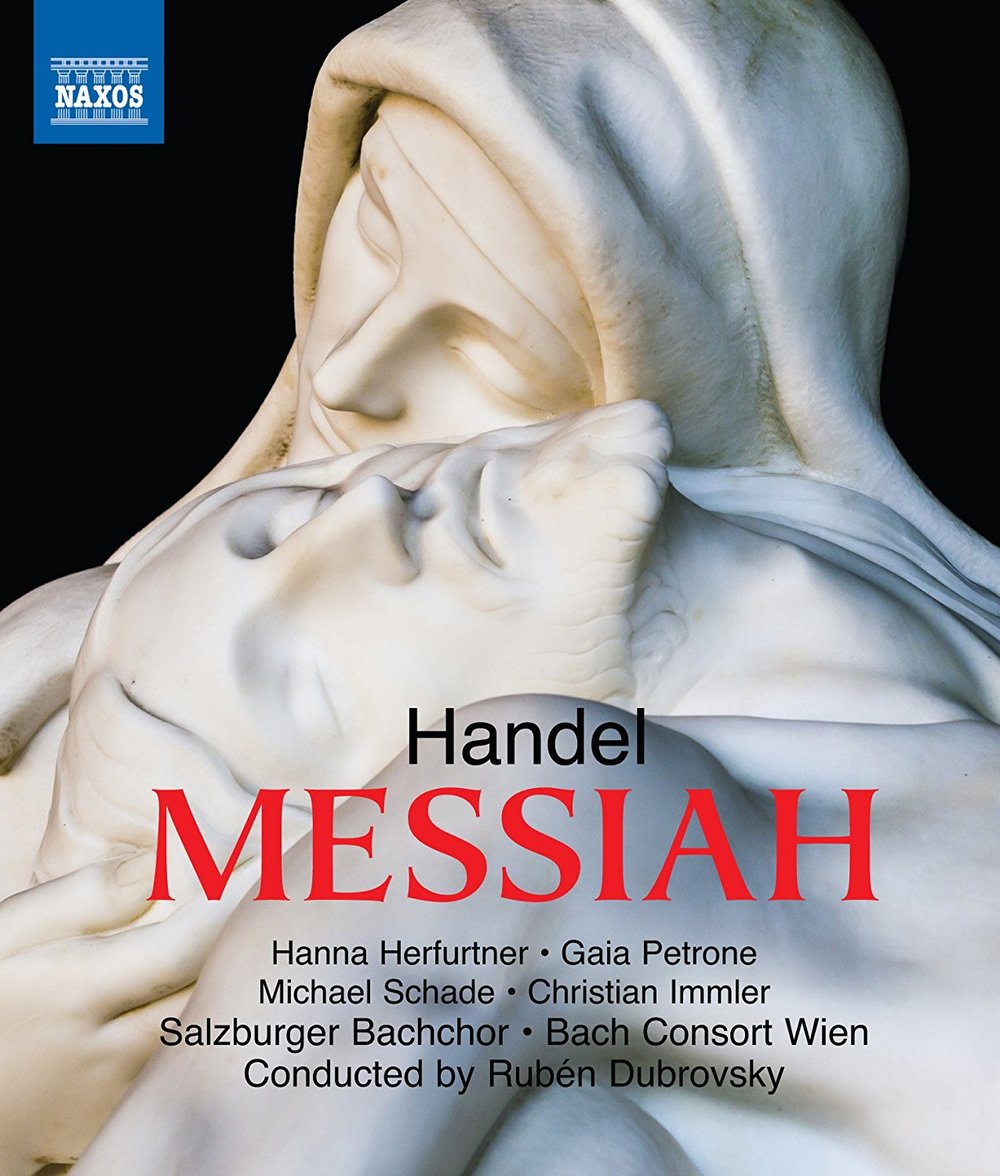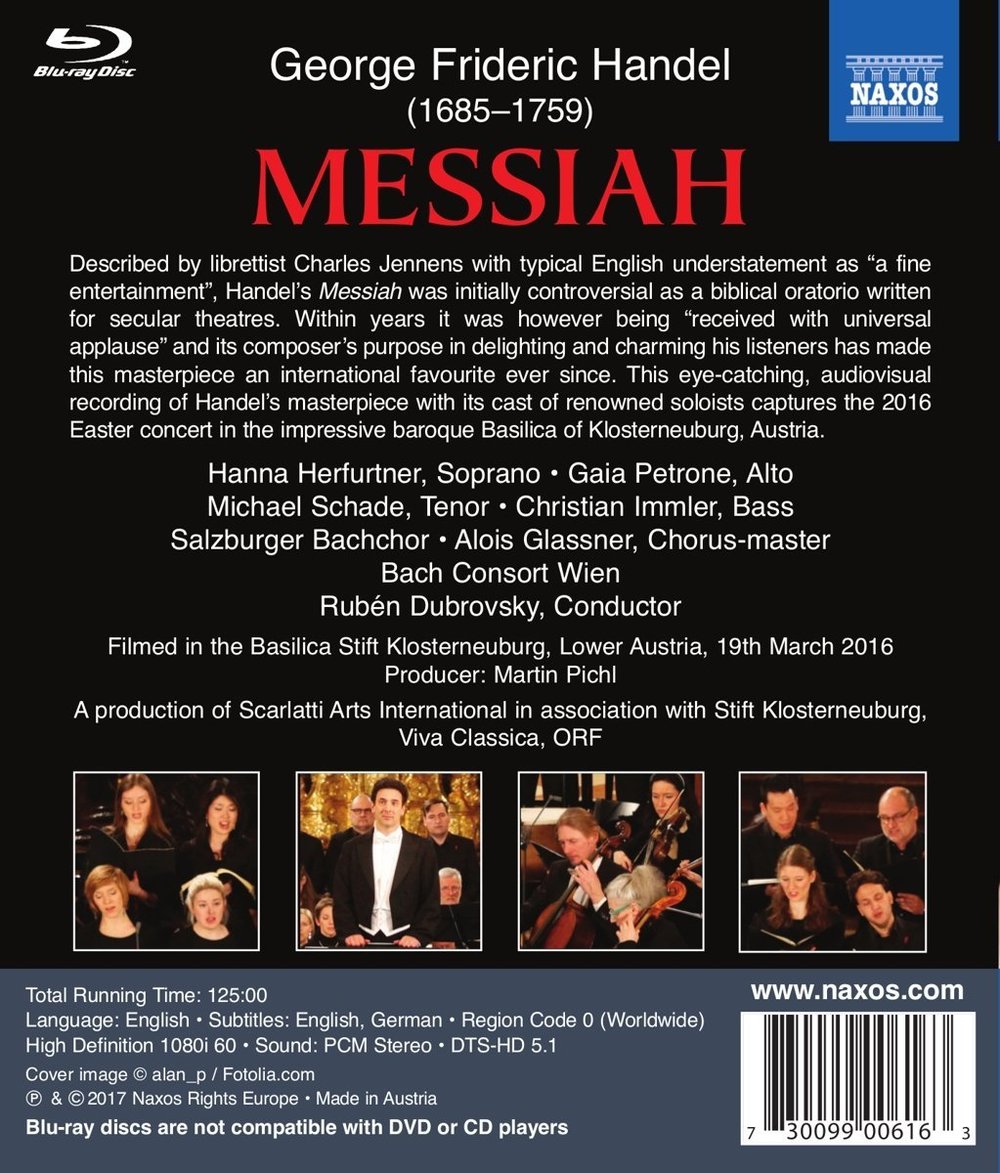

Handel Messiah oratorio to libretto by Charles Jennens. At Easter 2016 Rubén Dubrovsky conducts the Bach Consort Wien and the Salzburger Bachchor (Chorus Master Alois Glassner) at the Basilica Stift Klosterneuburg in Austria. Stars Hanna Herfurtner (soprano), Gaia Petrone (alto), Michael Schade (tenor), and Christian Immler (bass). Subtitles in German and English only. Produced by Martin Pichl. Directed for TV by Volker Werner). Released in 2017, disc has 5.1 dts-HD sound output. Grade: C+
We start with two shots of the exterior of the Basilika Stift Klosterneuburg (Basilica of the Neuburg Monastery Foundation). The images are clear throughout, but the colors seemed muted:
Next below is a nice whole-orchestra view. I (Wonk Bryan Balmer) suspect the photography here substantially understates the splendor of the interior. Also remarkable is the fact that this picture was probably made by a drone! Yes, this title could have been called “Messiah Takes Flight”, as a good portion appears to have been filmed by a flying camera. While the images below look pretty, please be warned that many are snapshots taken from moving sequences. The panning and zooming sometimes diverts attention from the images themselves. (I couldn't hear any droning sound, so I could be wrong that a drone was used. Perhaps cameras were hung from wires.)
The forces seen above are quite modest: 8 violins divided equally between 1st and 2nd, 2 violas, 2 cellos, 2 double basses, 2 oboes, 2 trumpets, 1 bassoon, 1 organ, and 1 timpani. There are 24 choristers (probably 6 each of soprano, alto, tenor, and bass). The sound is of standard Blu-ray quality. The church is highly resonant, but this is conveyed without being distracting.
And here next below is a dramatic view from the altar facing, I think, toward the entrance of the basilica. Would a drone be allowed to fly this close to the side of the building? Perhaps this was made from a small stationary camera operated by remote control:
Next below is a weak and poorly-framed shot of conductor Dubrovsky:
But next a much stronger shot of the conductor:
It was a little difficult to call which choir shots are small scale and which are large scale. I classified the first shot below as large scale:
And this next one below I classified small scale. It looks to me like a "bunch of heads":
Similarly, for soloists, we do not want to see “just a head.” We want to see context, i.e. other performers, the concert hall, etc. I called the next two shots below “Soloist - Not Realistic.” The first shows soprano Hanna Herfurtner and focuses on her head:
And this next view below shows two heads in confusing juxtaposition:
Now admire the next shot below of alto Gaia Petrone. This view I call "Soloist - Realistic." It's a beauty because it shows the singer's whole body in her glorious environment:
And next below is a dramatic shot of tenor Schade in a setting that makes sense:
Now let's move on to an image that is both a realistic-soloist view and a pretty whole-orchestra angle:
Alas, there are too many instrument-only shots in this recording:
And also too many shots that are poorly framed. Professional musicians are not allowed to make mistakes that can be detected by the public. So mistakes like these by videographers can likewise not be tolerated in a professionally-done video:
Here's an example of the "conductor-over-backs" shots that we condemn:
But now I end our screenshots two larger-scale views that we applaud:
I enjoyed the soloists for the most part, especially the bass and the soprano. But I add a few remarks for readers deciding whether to invest in a product intended for repeated viewing/listening:
Especially in the opening "Comfort Ye," usually one of my favorite moments of the piece, I felt as though the tenor used excessive ornamentation. This may be fine for a one-off performance, but has become tiring for me upon multiple hearings.
Despite conveying a buttery tone with exceptionally smooth runs, I find the alto’s English language pronunciation to be occasionally distracting. For example, in “O thou that tellest good tidings to Zion”:
“that” sounds like “dat”
“with” sounds like “wit”
“God” sounds like “Gott”
“the” sounds like “da”
Now let's move on to the subject of video content. I know Messiah well from live performances and recordings. The video style produced by Martin Pichl is consistent throughout this whole disc. Here are my HDVDarts statistics for the 31 minutes, 10 seconds of the first movement (up to and including the bass aria "The people that walked in darkness"):
Duration: 31 min, 10 sec = 1870 seconds total
Total video clips: 276, which break down as follows:
35 = conductor-only
3 = conductor-over-backs
35 = soloist(s) not realistic
55 = soloist(s) realistic
81 = solos, small sections, small groups, and DVD-like views
13 = large sections, large groups, and HDVD-like views
7= part orchestra
12 = full orchestra
16 = instrument only (IO)
19 = architectural and art views.
The pace, or average length of the video clips, is 6.8 seconds per clip (1870/276), which is way too fast. 32% of the clips are "supershots", i.e. realistic soloists, large sections, large groups, part-orchestra and whole-orchestra shots (not including the architectural shots of the church). Conductor shots are only 14% (which is good), and 61% of the soloist shots are realistic (which is excellent). I'm confident that the statistics for this whole video would be about the same.
In our special article on DVDitis, we have determined:
“A good HDVD should have a slow pace with more than 10 seconds per video clip on average (longer the better). 20 to 40% of the clips should be large-scale supershots (higher is better). Conductor shots should be less than 20% of the clips in the video (way less really). Over 50% of soloist shots should be realistic.”
This Messiah flunks the pace test because the average clip is substantially shorter than 10 seconds. But it passes all the other tests.
Now for a grade. Start with an A+. I subtract a full letter grade for the too-quick pace, bringing us to a B+. I feel this title is less appealing to me than the American Bach Society recording I reviewed earlier. I therefore doubt I will listen to subject title often in the future. For this reason, the large number of IO shots, and video composition errors, I make a further reduction in the grade to C+.
(Wonk Bryan Balmer did 95% of the work on this review. He spotted this item, bought it, and worked up all the review observations and screenshots. Hank McFadyen contributed 5% by editing.)
OR





















